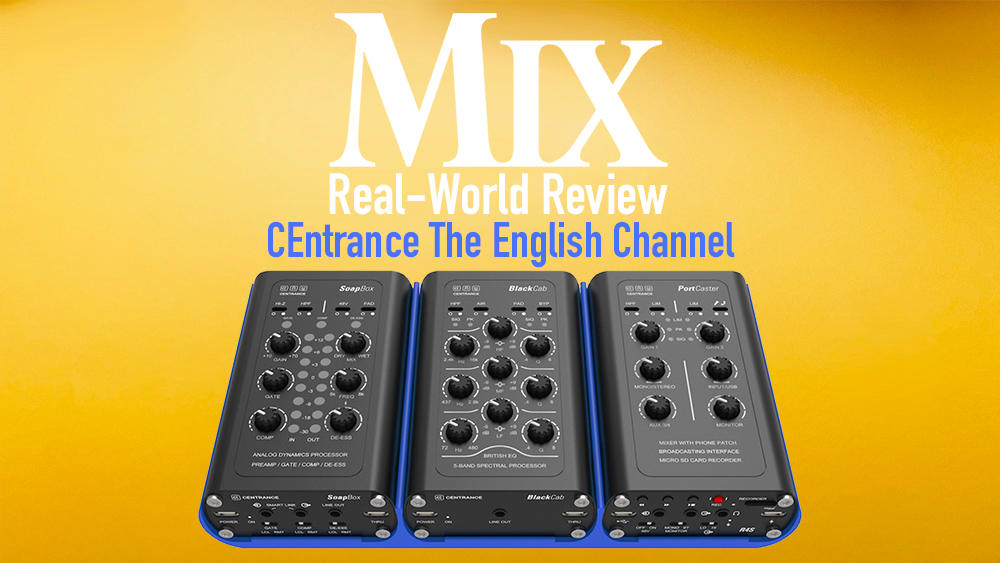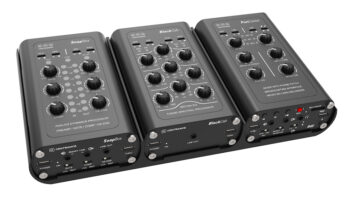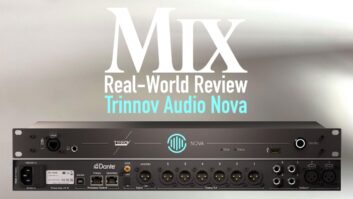
| MIX VERDICT: CENTRANCE THE ENGLISH CHANNEL |
| THE TAKEAWAY: “If the goal of CEntrance was to provide the equivalent of a console channel, they succeeded. However, it’s a powerful tool for live streaming and other online audio projects.” |
| COMPANY: CEntrance • www.centrance.com PRICE: $1,499.99 PROS: • Analog signal chain and processing optimized for voice recording and online streaming. • All controls on knobs and switches. • Impressive sound quality. • Small footprint. • Mix-minus feature facilitates phone interviews. • Limiter on both channels. • SoapBox offers plentiful gain. • Two additional mic preamps in PortCaster. • Easy to use and powerful Compressor, De-Esser and Gate. • Three-band analog parametric EQ. • Protective case included. CONS: • Only one input at a time through the channel processing. • Some might not like the look of the plentiful external cabling. • Recessed switches can’t be operated with your fingers. • Pricey. |
New York, NY (February 12, 2024)—CEntrance is known for making small-sized, high-quality audio interfaces, processors and converters, among other products. Its most recent release, the English Channel, is a conglomeration of three units: the PortCaster R4S, a streaming USB interface with a MicroSD recorder; BlackCab, an EQ; and SoapBox, a preamp/compressor/de-esser/gate.
The three units connect to produce a quality channel strip with all-analog processing. CEntrance says the English Channel earned its name because its components feature “proven British console technology.”
Its signal path is all-analog, except for the USB output and the MicroSD recorder in the PortCaster, for which the signal requires conversion. If you want to tap the signal before it’s converted, the PortCaster also has a 3.5mm TRS output.
The English Channel can support up to three mic inputs at once plus a stereo auxiliary input, but it outputs a maximum of two channels. Only one input, which connects through the SoapBox, can go through the dynamics processing and EQ at a time. The other sources get plugged in through the PortCaster at the end of the chain.
CEntrance designed this product with spoken-word recording in mind. It’s aimed at podcasters, YouTubers, voice-over artists, audiobook narrators and anyone looking for a quality setup that’s portable. The PortCaster offers features and I/O that facilitate live streaming and podcast production. You can also get excellent results using the English Channel as an interface for music recording, assuming you don’t need more than two channels in and out.
OUT OF THE BOX
The English Channel comes in a sturdy plastic carrying case with a fold-out handle and latches on three sides. Everything fits inside the case, including hardware and cabling.
All three processors—each approximately 2.75 inches wide, 4.75 inches deep and 1.25 inches in height—come attached to a sturdy plastic frame that CEntrance calls the “Commander Console.”
The component units can also be used individually and are not permanently attached to the console. You can remove them by loosening the set screws on the bottom of the frame. You can choose from one of eight colors for the Commander Console when you order your English Channel.
Among the included cables are a pair of XLR-to-XLR jumpers for connecting the audio from the SoapBox—the first unit in the chain—to the BlackCab and then to the PortCaster.
Power comes from a 5V USB-A power block, which you plug into the SoapBox with an included USB-C cable, which connects to a USB-C to-A adapter and a USB-A 5V power block. To get the power from the SoapBox to the BlackCab and PortCaster, two more USB-C cables are included, and they plug into ports on the lower front panels of the BlackCab and PortCaster. When the power cables are connected, a single switch on the SoapBox turns all three units on or off.
One of the big selling points of the English Channel is that all of its controls are tactile—there are no screens or menus to navigate like there would be on a digital device. This allows for faster adjustments during a live production, where there isn’t time to sift through menus.
Like other CEntrance products, such as the MixerFace, the controls are small. The knobs are about 1/4-inch in diameter, and virtually all the others are recessed dip switches.
SOAPBOX AND EQ
The first unit in the chain is SoapBox. It features a mic preamp and three analog dynamics processors: a VCA compressor, a gate and a de-esser. It has one XLR/1/4- inch combo input that can handle mic, line and instrument signals and one XLR output. Using its recessed switches, you can switch on and off 48V phantom power, a High-Pass Filter and a -28 dB Pad.
The SoapBox’s mic preamp offers impressive specs: 70 dB of gain and an EIN of -130 dB. Anecdotally, I found the gain plentiful, even when using dynamic or ribbon mics. Keeping track of levels is easy, thanks to a large, eightstep, LED ladder-style meter with columns for input and output.
The compressor features a dedicated ratio knob labeled Comp and a Gain knob that’s also a threshold control. It sounds quite good, and its ability to control levels is handy for live streaming.
You control the Gate with a single knob, which adjusts its threshold. There are no controls for attack, release or hold, but CEntrance did a solid job setting the fixed values for those time constants. The Gate is quite effective for removing background noise, which is useful when recording spoken-word audio.
The De-Esser controls include a Frequency knob (5 kHz to 8 kHz) and a De-Ess knob that controls the threshold. I found it easy to dial in effective settings by turning up the threshold and sweeping the Frequency knob.
The SoapBox also sports a Dry/Wet knob, which affects all three of its dynamics processors, allowing you to add a little unprocessed audio if your voice or other source is sounding too dry or sterile.
The BlackCab provides a single XLR input and output. The former is for bringing in the signal from the SoapBox, and the latter is for sending it to the PortCaster.
The EQ on the BlackCab is a three-band parametric configuration with bell filters.
Controls on each band include Frequency, Q and Gain. Four recessed switches toggle on and off a High-Pass Filter, a -20 dB Pad, a Bypass and one called Air. The latter switches in a high-shelving filter to add subtle top-end sparkle. The EQ is clean-sounding and capable.
DREAMING OF STREAMING
The third and most consequential unit in the English Channel audio chain is the PortCaster R4S, which is based on the CEntrance PortCaster R4D. The latter has similar features but is battery-powered.
The R4S combines a pair of mic preamps, rudimentary mix controls, a standalone recorder and a USB-C audio interface. The unit offers Gain knobs for each channel and a Monitor knob that governs the level of the unit’s 3.5 mm Headphone output.
The XLR Input 1 on the PortCaster would typically receive the audio signal from the BlackCab, leaving one open input, but there’s a workaround: the BlackCab has a 3.5mm output, and the PortCaster has a matching input. If you connect the processed signal that way, you keep both XLR inputs available for mics.
The Input/USB control lets you change the balance between the signal coming from the analog input (or inputs) and that returning from the computer, so that you can minimize any latency.
If you create any live-streamed audio, the PortCaster offers several appropriate features. It has a TRS aux input jack (mono, cable not included) that you can use as an analog input for a phone signal to do phone interviews for a podcast or other production.
Moreover, one of the recessed switches on the front panel turns on and off what’s referred to as the “mixminus” feature, which is critical for phone interviews. When it’s on, the caller connected through the TRRS port will hear the monitor output minus the return of their voice.
Also, each channel has a soft-knee limiter that can be switched in and out of the circuit. If you’re live-streaming, using the limiter reduces the chance of clipping during your program.
The Aux Input on the PortCaster can also bring in external audio from a laptop, mobile device or any source on a 3.5mm cable. You could use that input for music, sound effects, or whatever incidental audio you need. The Aux 3/4 knob makes it easy to adjust the level of that external audio.
Because some streaming apps require a mono signal, the PortCaster features a Mono/Stereo knob that affects both the USB and 3.5mm outputs. The unit also has a Mono/Stereo switch on the lower front panel for the headphone feed, which is nice when you don’t want to hear the inputs hard-panned.
And if all that wasn’t enough, the PortCaster contains a built-in, 24-bit, 48KHz MicroSD recorder. The card slot and the recorder controls, including a one-touch record function, are on the lower front panel.
SWIMMING THE ENGLISH CHANNEL
I used the English Channel for various recordings, both to the MicroSD card and into Logic. I recorded my voice, both speaking and singing and DI electric guitar and bass. I tried condenser, dynamic and ribbon mics. The sound quality was clear and clean, and the processors were effective. If the goal of CEntrance was to provide the equivalent of a console channel, they succeeded.
However, with its mix-minus capability, built-in recorder, physical knobs for critical parameters and flexible I/O, it’s a powerful tool for live streaming and other online audio projects.
Some might find its price an impediment, especially when considered on a per-channel basis, but remember that you’re getting three processors for that price rather than just one.
If a portable, high-quality, analog signal chain with compression, de-essing, gating, EQ and limiting appeals to you, particularly if you’re creating professional spoken-word content, you’ll find the English Channel a worthy investment.







